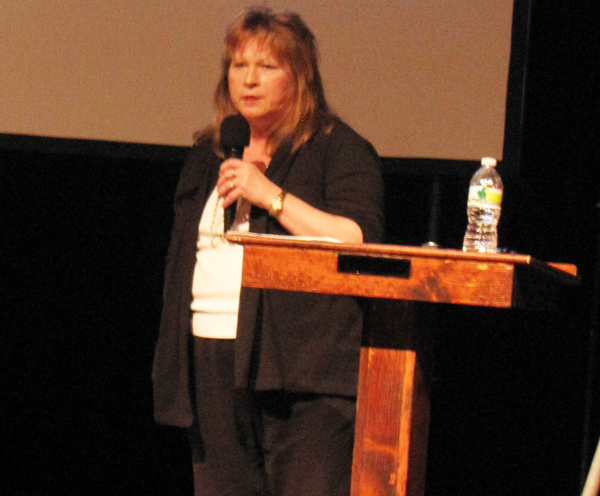Environmentalists and town officials decry
General Electric plan for river cleanup
By David Scribner
LENOX – Furious opposition is arising to General Electric’s proposal to locate three toxic waste dumps within Housatonic, Lenox and Lee, as part of the removal of PCB contamination from the Housatonic River and its floodplain, rather than ship the toxic residue by rail to certified disposal sites.
Released last week, GE’s 1,200-page plan for removing the carcinogen, polychlorinated biphenyls from the river below Pittsfield, envisioned the construction of three dump sites where the toxic material would be permanently stored. The company offered a minimal cleanup, implying that natural dispersal of the toxic chemical would be preferable.
At a public information session at Town Hall Tuesday, Secretary of Energy and Environmental Affairs Ian A. Bowles, joined by Department of Environmental Protection Commissioner Laurie Burt and Fish and Game Commissioner Mary Griffin, heard an earful from South County residents.
“We have worked for 20 years to enhance our town, to make it appealing to visitors,” declared Lee Selectman Pat Carlino. “We don’t want people getting off Exit 2 of the Mass Pike to see a PCB dump. We will fight it.”
Neither the federal Environmental Protection Agency nor the Massachusetts DEP have yet had time to formally respond to the GE proposal.
“The public comment period is 30 days, but we will extend it to 60 days,” explained EPA District Administrator Susan Svirsky.

For 40 years, until they were banned as a carcinogen in the 1977, GE let millions of pounds of PCB-laced liquid seep into the river from its Pittsfield manufacturing facility where they were driven downstream.
“Three potential locations for an Upland Disposal facility have been identified to date,” the GE document states. “These sites are located near Woods Pond, Forest Street in Lee – the road leading to Goose Pond –and Rising Pond.”
The GE report confirms that it would prefer to use truck traffic to transfer toxic waste from the river basis to the dump sites, although the EPA had directed the company to consider rail transportation that is adjacent to the river.
Tim Gray of Lenox Dale, founder of the environmental organization Housatonic River Initiative, noted that one potential dump site could be situated within Woods Pond itself, a technique that uses dams to confine the pollution in one section of the water.
In Housatonic, the whole west side of Rising Pond would become a capped PCB dump. In Lee, the proposed PCB dumps could also be on Lane Construction site adjacent to Woods Pond, and in gravel pit on Forest Street that leads to Goose Pond.
“Will they be another Hill 78 in Pittsfield, where sludge from the river was dumped next to an elementary school?” he asked.
The GE submission states that the 104-acre Rising Pond would need a disposal site of 84 acres, 44 of which would be a landfill, in order to handle 2.9 million cubic yards of contaminated soil.
For 75-acre Woods Pond, the landfill would require site of 75 acres, a landfill of 18 acres, to cap 2 million cubic yards of contaminants. The Forest Street site would be 195 acres and would handle 1 million cubic yards of waste on a 34-acre landfill.
On the other hand, Berkshire sportsmen were concerned about the damage to the river’s ecology if all the contaminants were removed by dredging.
“We need an environmentally sensitive approach,” noted Mark Jester, president of the Berkshire County League of Sportsmen’s Club.
But Shep Evans of Stockbridge argued that the cost of cleaning up the river goes far beyond the dollars involved, estimated to be in the millions, if not hundreds of millions of dollars, depending on how thoroughly the river is cleaned.
“It will take a huge amount of time, political anguish and sacrifice by everyone, to clean up a mess that should never have been made in the first place, but removal of contaminated soil is a public works project, and we know how to do that,” he reminded the environmental officials. “The restoration is doable, and we should remember that the river changes all the time. It is its own architect, and after it’s cleaned up, it will re-establish its own course. But it will be clean – and far better, because we won’t be condemning future generations to living with a contaminated river t hat they can’t use.”
Mickey Friedman of Great Barrington was skeptical of GE’s intentions: “Everything that GE is doing with its proposal is designed to scare people into imaging the worst kind of cleanup. GE knows there are environmentally sensitive ways to remove PCBs. But there is a billion dollars at stake for GE. They are not to be believed. PCBs are terribly toxic. Only a careful and complete cleanup will keep wildlife and people safe.”
